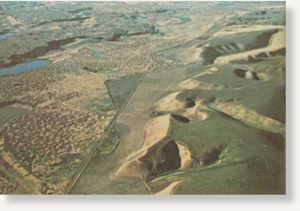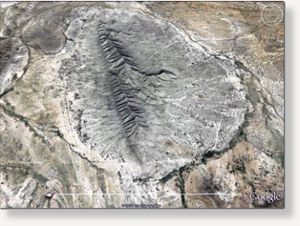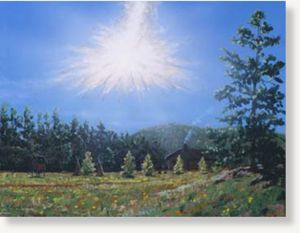Comment: With all of the data we've gathered here on SOTT over the past several years showing an increase in fireball and meteor sightings,
we believe that studying impact events and understanding the fallout
from such events is a pursuit of supreme importance for all of humanity.
While it may not be the most comforting thought to know that we live
at the center of a cosmic turkey shoot, having knowledge of what may
befall us at any time is better than having none at all. Knowledge,
once applied, can ultimately protect, but having knowledge first is key.
And mainstream geologists - who've instead chosen to bury their heads
in the sand - have done little in terms of helping humanity understand
or prepare for such disasters.
We recently featured the article A Different Kind of Catastrophe - Something Wicked This Way Comes
by Dennis Cox where he lays out the evidence for impacts that don't
conform to the usual crater formations. The following is part of an
exchange we had with Dennis on this topic of mutual interest, and the
problem of malfeasance in the Earth sciences towards catastrophic
events. The interested reader may want to follow up on the suggestion
offered at the bottom.

© Unknown
A
pig in a poke or a cat in a bag? Mainstream science offers the latter
when it comes to understanding catastrophic earth-changing events.
A
pig in a poke or a cat in a bag? Mainstream science offers the latter
when it comes to understanding catastrophic earth-changing events.
A couple of years ago, as a hobby, and pastime, I set out to see if I
could work out a better way of identifying potential sites to go
meteorite hunting. I had learned to do battle damage assessment from
aerial reconnaissance photos a long time ago in the Army and the blast
damage, and ground effects from an explosive event, are pretty much the
same, no matter what the source of the explosion might be. It's only a
question of scale, and explosive force. Visually, there is very little
difference in the appearance of a bomb crater, and an impact crater of
the same size. So the military style forensic technique of reading the
patterns of movement in the emplacement of blast effected materials on
the ground applies well in the search for potential impact related
geology. The quality of the image data now commonly available to anyone
with a good PC, an internet connection, and a copy of Google Earth, is
excellent. In the past five years, the publicly available image data has
really come into its own. And today's 21st century satellite imagery
allows us to study the surface of the Earth at a level of detail our
fathers could never have imagined.
Almost a century ago, using aerial photography, a geologist named Harlan
Bretz noticed evidence for the mega-floods that sculpted the Grande
Coulee, and the 'Channeled Scablands' of eastern Washington. What he had
found, were the patterns of fluid flow, like the ripples you see in the
sedimentary deposits of a stream bed, but these 'ripples' are hundreds
of feet high. He saw them as empirical evidence of a major catastrophic
flood event, on a scale that the standard theorists of his day thought
was inconceivable.
Harlan Bretz was the first to use Aerial photographs to detect,
and map, catastrophic mass movement of the Earth's surface materials.
The aerial views allowed him a perspective from which patterns of fluid
flow, and catastrophic mass movement of terrain materials, could be
perceived on a scale that had been unimaginable until he described them.
And most of the academic community of his time thought he had a screw
loose, or two. After all, most geologists by that time had already
decided to agree without question that sudden, catastrophic, geologic
changes just don't happen anymore. And that all geomorphology on the
surface of the Earth is the result of slow processes we see going on
around us today, and requiring millions of years. They believed that
"The present is the key to understanding the past", and that the rocks
of that area were all 'well defined'. They were mistaken.
The trouble we face today, Just as Mr. Bretz did back then, is
that through some 19th century process of mutual-inter-assumptive
reasoning, and confabulation, instead of sound, experiment-driven,
science, and for more that 150 years, the Earth sciences have been
founded on that unquestioned 'Gradualist' assumption. But
gradualism only works until something sudden happens. And if you want to
understand, or predict, the nature of the planetary scarring of a
geologically recent catastrophic event, especially one that's different
from anything that's ever been studied before, that 19th century,
gradualist-assumptive, reasoning just won't get you there.
Apparently, being able to see the truth is no guarantee that anyone's
going to bother to look where you're pointing anytime soon. It wasn't
until 1965 that a report from an independent geologist's tour concluded
that Harlan Bretz was right about the catastrophic geomorphology that
resulted from an early Holocene event he'd called 'The Spokane Flood'.
And finally, in 1976, at the age of 96, he was awarded the Penrose Medal
of the Geological Society of America. Which is just about the most
prestigious award a person can get in the field of geology. Upon
receiving the award, Mr. Bretz is said to have complained to his son
that he couldn't gloat properly, because all of his enemies were dead.
The
satellites of today have upped the ante. Harlan Bretz could see
evidence of catastrophic material movement on a statewide scale. With
the imagery now available through Google Earth, we can detect, and read,
patterns of catastrophic mass movement of terrains on a continental
scale. The event Bretz perceived was only implausible from a standard
theory viewpoint because of its size. And yet, by comparison, and in the
final analysis, someday it may be seen that his glacial mega flood in
the Pacific Northwest was only a minor little footnote in the events of
the early Holocene. And some of those events were far more terrible then
a glacial flood event.
One of the biggest mysteries I've ever confronted is in the question of
how theoretical geology could be so far removed from the empirical
reality now clearly legible in modern satellite images. I couldn't
understand how the geomorphology of the catastrophic terrains of central
Mexico, could be almost completely unstudied, and unexplained, except
by fanciful speculation that just doesn't hold up to close scrutiny. To
be fair publicly available image data has only come into its own in the
past three, or four years. And many of the terrain features in question
are not all that visible from ground level.
The old cliches like 'buying a pig in poke', 'don't let the cat out of
the bag', and 'empty sack of lies' all have their roots in the same old
con. It went something like this: At an old country fair, a con artist
would approach a likely looking mark to sell him a piglet in a 'poke'
bag. But it's not really a pig in the bag; it's a cat. The cat wiggles,
and squirms, just like a little pig when you poke him through the bag.
And as long as the bag stays closed, the con works just fine. But as
soon as the bag is opened, the cat escapes. And the victim is left
holding nothing but an empty sack of lies.
The root problem in the Earth sciences today goes all the way back to
Gottfried Leibniz, in the early 18th century, and his slogan of Natura
Non Facit Saltus, (Nature does not jump). Leibniz may have been a
mathematical genius. But he wasn't worth a damn as a geologist. He wouldn't even pass a 5th grade geology test of today.
But he had the full backing of governments, big business, and the big
churches. Because he believed, and taught, that the Great God of the
Universe had created planet Earth, with all its flora, and fauna, just
for us, and to do with as we damn well pleased.

© Unknown
Gottfried Leibniz - The grandfather of uniformitarian thinking in geology. "Nature does not jump"
Gottfried Leibniz - The grandfather of uniformitarian thinking in geology. "Nature does not jump"
Linnaeus
and Darwin loved Leibniz. And they quoted him verbatim. He managed to
almost completely eliminate any academic consideration of episodic
worldwide catastrophes from western thinking. And by the time James
Hutton, and Charles Lyell, came along, most geologists were
well-conditioned followers of his way of thinking. Hutten may get the
credit in the history books for the origin of Uniformitarianism. And
Charles Lyell popularized his ideas in his book 'Principles of Geology'.
But Hutten, and Lyell, just picked up on Leibniz's thinking, and ran
with it. They weren't brilliant geological thinkers either.
But their unquestioned uniformitarian/gradualist assumption, based on
the idea that the earth was shaped only by slow-moving forces still in
operation today, and expressed in the slogan of "The present is the key
to understanding the past", has become the foundation postulate of the
Earth Sciences ever since. Governments, and big institutions, loved it. They
bought it like a pig in a poke. And they bought with generous funding
packages that came with rules that shut the door to any publication, or
consideration, of sudden catastrophic events, as a possible driving
force in the geo-morphology of this world for more than 150 years. That's a cruelly long time time to leave the poor kitty in a bag.
It all fits a familiar theme, don't you think? I'm mindful of high
priests proclaiming that; "God is in complete control folks, (and by
extension, his priests) rest assured that the universe is unfolding
slowly, uneventfully, and gradually, just for you, and just as he
intended. Now be good sheep. Pay your taxes, and tithes, faithfully.
Don't ask too many questions. Put your head down. And get back to work
before he gets pissed off, and your crops fail."
But the questions of just what the hell happened around 13,000 years ago
that caused the extinctions of the mega fauna in North America, the
disappearance of the Clovis culture, and a return to Ice age conditions
that lasted more than a thousand years, has caused us to take a closer
look, and I'm afraid we've let the cat out of the bag.
The trouble, is that at least with regards to central Mexico, and much
of the American south west, their unquestioned assumptions that
significant, and geologically recent, catastrophic events just don't
happen, or at best are highly unlikely, can be shown to be as naive, and
just plain wrong, as flat world theory. And by extension, almost every
geologic theory that's been founded on that unquestioned assumption
becomes suspect, needing re-evaluation. And the whole edifice comes
tumbling down.
As an autodidact I was both startled, and amazed, at how much the voices
of authority don't really know at all, but have merely assumed to be
true, based on the opinions of others. And which reasoning, and
assumptions, were themselves based on faulty, yet unquestioned
assumptions, of generations before them.
Unfortunately, it turns out that much of what we have been taught to
believe about the geo-history of our world is not based on sound,
experiment-driven science. But is founded instead, on an
antiquated system of mutual-inter-assumptive confabulation that is
rooted in that unquestioned uniformitarian paradigm. In other
words, the very foundation postulate behind the reasoning that produced
their geologic theories was wrong from the beginning. So many
catastrophic possibilities have been denied, or ignored, that when a
geological question regarding catastrophic geology gets answered with a
phrase that begins with the words, "Well, most geologists agree
that______", (fill in the blank) it should carry the same weight as,
"Well, most high priests, and scribes, agree that the world is a large
flat disk, carried through the universe on the back of a giant turtle,
while the sun, moon, and stars, dance merrily across the heavens above."
The first time I heard that one was when I was a kid, and I wondered
what was holding the turtle up. I forget who told me it was turtles all
they way down. But the way I see it, most uniformitarian/gradualist
based theoretical geology, especially with regards to the consequences
of a catastrophic impact event is also turtles all the way down,
The reason that there are few documented impact structures is not
because impacts, or their resulting structures are rare. It is because
we didn't know what happens to the ground in a very large airburst. It
has long been assumed that impact events only make craters. The role of
the atmosphere has been vastly underestimated. And airburst phenomena,
and the potential for ablative geomorphology in a very large airburst
has been completely overlooked. Until we saw the fragments SL-9 hit Jupiter no one could have imagined such energies coming from the sky. And no one could have imagined that there might be such a thing as a geo-ablative airburst event. Or a cluster impact event.
Nor could they have imagined what 1.1 billion tons of cometary debris,
all falling in the space of an hour, or less, might do to the ground.
But it works out to something like 10,000 examples of Mark Boslough's
simulation. And most of it was in two clusters that only took a few
seconds each.
But the reason that no seismic, tomographic, deep penetrating radar, or
any other data has ever revealed, or confirmed, the existence of even
one of the giant, magic trap door rifts of the so called "Mid Tertiary
Ignimbrite Flare Up" that opened, and closed without a trace, or the
supergiant magma chambers, is simply because It never happened. In fact,
there is no such thing. Now that we know what an ablative airburst can
do, we can make the case that The Chihuahuan Ignimbrites of central
Mexico, and most sheet ignimbrite deposits, anywhere in the world where
the volcanic source remains a mystery are, in fact, probably the work of
an ablative airburst storm. Once you know what to look for, the scars
of these things are as common as craters on the moon. In other words,
the mystery of the missing craters is solved.
I've
often been told that to really flesh my theories of the planetary
scarring of a geo-ablative airburst event, and cluster impact events, I
really need to get some field work done. Heck those folks are preaching
to the choir. But to tell you the truth, I'm as poor as a church mouse.
And the funding for all the field work has been so far out of my reach
that I haven't really allowed myself to dwell on it much... Too
depressing. Sometimes I wish I could meet a semi retired someone with a
big RV, some time on his hands, and a desire to see some of the
damnedest terrains on this continent that they don't tell you about on
the maps, or travel brochures. And maybe even carve out a place in the
history books. Heck, if someone's going to tour the country anyway, why
not make it count for something?
But to do a cheap round robin trip to a few of the main regions I'm
studying would entail a road trip of a little over 5000 miles. At a
conservative average cost of $1.50 a mile, transportation logistics, and
fuel costs, would be in the neighborhood of $7,500.
Extra instrumentation, such as portable GPS, ruggedized, laptops and
good cameras to document every thing would be critical. A portable
satellite dish to allow communication from remote campsites would be
also be helpful. And a portable XRF analyzer would be almost priceless.
Also helpful to study some of the small craters in west Texas, and New
Mexico, would be a portable ground penetrating radar unit. Although the
trip could still be a success without one. That trip for two, with
portable electronics included would run somewhere between $10,000, and
$15,000.
The trip would go to some of the craters, and airburst scars, in New
Mexico, and locations southwest, and west Texas, then to swing north up
into northern Minnesota to get specimens from the some of hydrothermal
burns where the LIS got hit. Especially some of the black splash of melt
near Upper Red Lake. From there we go to Southwestern Montana to get
specimens from some of the oval craters in the Rock Rock River Valley.
On the way, we could visit a couple of amazing places in Wyoming I
haven't mentioned online yet. And then down through Northern Nevada, to
get specimens from the oblique craters in a dry lake there.
The ideal scenario would be to use the business plan of doing the road
trip as a documentary. And take a good film crew along. As a film
production, overhead costs could easily triple. But the locations, and
terrains are interesting enough to make an exceptional documentary film.
Even if detailed analysis of specimens were to fail to produce a single
ET signature.
One way it's money spent on doing good science in the field. The other
way it's money invested in the entertainment value of doing good science
in the field. But either way the focus needs to be on doing
good science, no matter what. And no matter the outcome the resulting
data might describe. So that even if the field data disagrees
with me, and my theories of airburst geomorphology, we still end up with
a documentary film that can provide a return on money invested for
field work.
So I'm not talking about just a paradigm shift, or a new kind of
catastrophic event. I'm talking about a complete revolution in the Earth
sciences from the bottom up.
Sometimes I feel like I am a little guy treading water in the deep end
of the pool. And some of the big kids want to drown me. The high priests
of the Church of the Grand Uniformitarian Confabulation are going to
hate me for this. But I'm not interested in redecorating the holy of
holies with new curtains. Or tossing out a few beggars. I want to tear
down the whole damn temple, and build a new school from the ruins.
Dennis Cox Website
Comment: It's pretty clear that humanity needs good
science if we are to survive and it is equally clear that we can no
longer rely on mainstream institutions to do good science for the
people. Good science doesn't mean taking an assumption and working
backwards to prove it, as uniformitarianists have done for the last 150
years, leading to a virtual dead-end. As Dennis states in his
previously featured article, "if you can describe a beast, you can predict its footprints."
And understanding those footprints could mean a lot to the survival of
the human race. Now that you know what Dennis is trying to do - good
science - and what he needs to do it, would you consider contributing
toward his work on this supremely important issue that affects us all?
If so, you can contribute via Paypal to rickrak77(at)yahoo.com



No comments:
Post a Comment